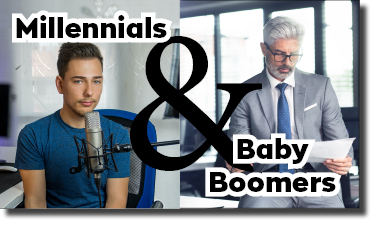A Stronger Focus at Both Ends of the Age Spectrum

Millennials outnumber Baby Boomers in the United States by almost eight million and represent more than a quarter of the American population. Our greatest sources of prospective clientele now fall upon the youth and those nearing retirement – opposite ends of the spectrum. As an industry, specifically in the life and disability insurance markets, we must cater to both of those demographics if our businesses are to prosper. But how do we focus on groupings of persons who seem to be so different including their values, ideologies and lifestyles? We must wear different hats at different times. We must be flexible and embrace sometimes contradictory marketing methodologies.
Baby Boomers represent the politically and socially radical past of this country, but they have now moved into a new era in life. They have families and grandchildren. They have become more conservative, and while many of your older clients may have embraced much of today’s incredible technologies, marketing preferences, in general, remain antiquated among matured audiences. They remain preferential to reading magazines and newspapers they can hold in their hands, and they respond more to direct contact and face-to-face sales techniques. A Boomer is a true salesperson’s prospect. They are self-aware of their age, their limitations and their need for financial protection. Their way of thinking is more analytical and deliberate, but can also be very stubborn.
Millennials, on the other hand, are a completely different breed. They generally believe they are physically impervious to accidents and sickness. Furthermore, they were born with cell phones in their hands and computers at their fingertips. They are impatient and think they know everything, or at the very least they think they can do everything better than previous generations. And they are probably correct. They can certainly attain information faster than ever before, and they are intelligent; more young Americans have college educations than ever before. But most importantly, Millennials understand how to use and leverage technology better than their forefathers which makes them adept in employing social media and other electronic resources to communicate, find their news, do their shopping and research and purchase their insurance policies.
So there is the dilemma. We are faced with two completely different demographics of prospective clients, both of whom are well worth the trouble of going after. Are your current marketing strategies going to afford you the opportunity of targeting both the young and those nearing retirement? You must adapt. Remain a true insurance salesperson, but do so on multiple levels, in multiple mediums to multiple audiences.
That is the reality. We must continue to diversify our marketing and sales techniques to reach all available markets. To industry outsiders, much of our world of life and health insurance seems mundane and tired, and the future of this business will inevitably be focused on technology, ease and efficiency of policy issuance and delivery.
Millennials certainly represent the present and future of the U.S. economy, and they have changed the way much of the world conducts business. To achieve success in this industry, we must embrace and indulge in the preferences of both the young and the old. These continue to be intriguing and challenging times, but the future holds endless opportunities if you are resourceful and able to adapt.